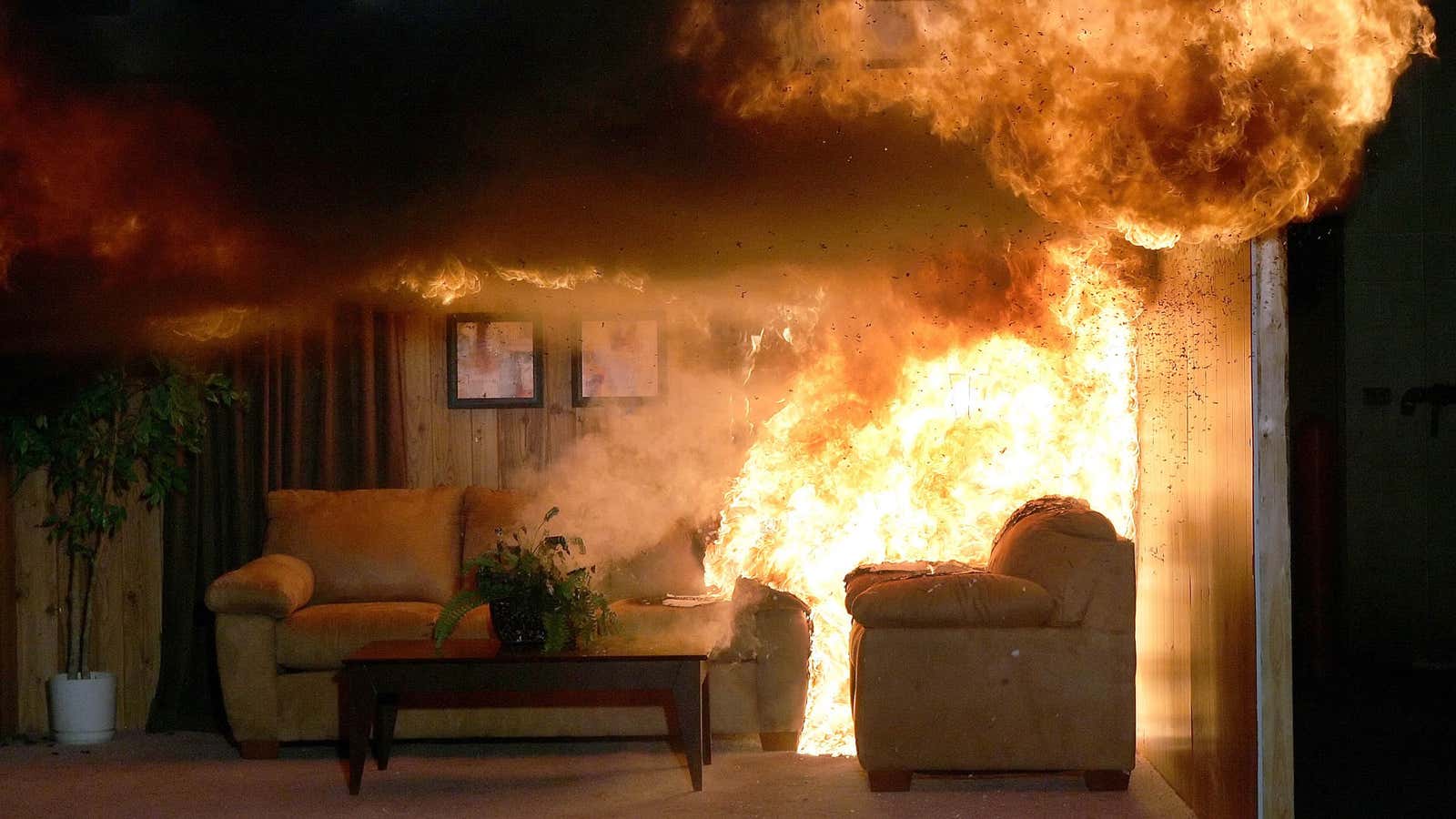If you’re reading this at an office desk or at home, look around, and pick up a few things.
Chances are, if they plug in, use heat or water, they’ll have a small circle sticker with “UL” written inside it somewhere. That means those products were inspected by Underwriters Laboratories (UL). It’s the little-known company that’s almost single-handedly responsible for making sure our products are built to standards that can handle a beating without going up in flames.
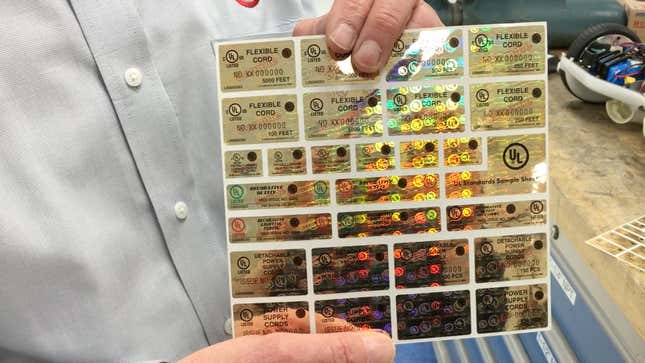
A few weeks ago, I was invited to UL’s headquarters in Northbrook, Illinois, to see how its technicians and engineers are testing hoverboards to ensure that the ones sold in the US are safe, as they’ve had a nasty history of catching on fire. The self-balancing scooters (that in no way hover) pretty much represent a UL testing engineer’s worst nightmare: They are a viral product, with demand spurred on by celebrities and social media, that led manufacturers looking to capitalize on a fad to push out a product as fast as possible. Many of them contain crimped wires, unshielded batteries that might not contain what they say they do, metal shavings, underpowered charging cables, and multiple other manufacturing defects that tend to occur when a product is rushed to market with little oversight. It was an opportunity for UL to show that it can react to the increasing rapidity and ease with which untested products from overseas are sold in the US.

As new products are introduced to the US—whether they’re hoverboards or a new type of toaster—companies turn to labs like UL to measure their safety. UL works with manufacturers, industry experts, other testing labs, and governments to determine what about a new product needs to be tested, and uses that as a base for creating testing standards for it, which often end up becoming the de facto standards of the US government. For example, with UL’s recent hoverboard standard, the government plainly stated that any hoverboard being sold in the US that doesn’t bear a UL sticker could be seized and criminal penalties could be brought against the manufacturer.
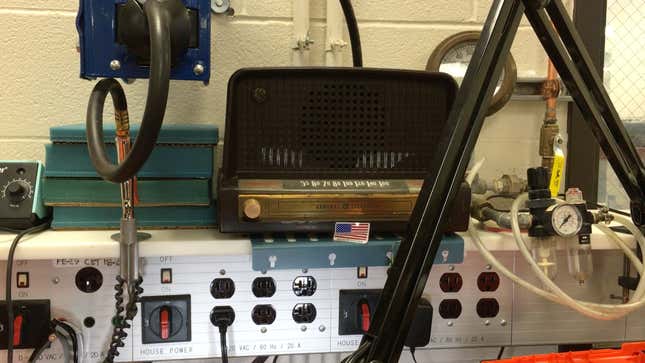
Barbara Guthrie, UL’s chief safety officer, told me that it took the company eight weeks to go from deciding that it wanted to test hoverboards to having a standard in place. “That was pretty much a record,” she said.
But as products can now be conceived of, prototyped, built, and shipped in a matter of weeks, keeping up with that sort of turnaround is daunting. Guthrie said she expects to see more products like the hoverboard in the coming years, and that each new standard will be done in record time. For the 122-year-old company with a mission to keep Americans safe, this is the new normal.
Exploding lightbulbs and a eureka moment
The company’s genesis can be traced back to the 1893 World’s Columbian Exposition, a world’s fair that took place in Chicago. A recent MIT electrical engineering grad, William Henry Merrill, was hired by insurers to investigate Nicola Tesla’s work illuminating the exposition, which apparently consumed three times as much electricity as the rest of the city of Chicago at the time. Buildings were catching on fire at the fair, and insurance adjustors wanted to know why. Realizing the myriad potential fire hazards that the burgeoning lighting and electricity industries could pose, Merrill decided to stay in Chicago and set up an organization dedicated to testing electrical products and writing safety standards for them.
More than a century later, UL is still contending with the same problems Merrill saw at the Columbian Exposition—short circuits, faulty wiring, shoddy manufacturing; anything that can cause a product to catch fire. But for the most part, our electronics and houses don’t spontaneously combust, and, in the US, that’s generally because of the increasingly specific and bizarre tests UL puts products through.

“There is so much necessity running in parallel—safety, technology, consumer behavior—that UL has to be involved in to make certain that we truly work for a safer world,” Guthrie said. And regardless of whether a product makes the leap from fad to long-term essential, it may need the UL stamp of approval. (I asked whether e-cigarettes or drones had UL standards—they don’t, yet, but 3D printing does.)
But while the products may change, UL still uses the same zany, methodical approach to pretty much everything electronic we touch in the US, according to UL’s longest-serving employee, John Drengenberg, the spokesperson who introduced the hoverboard standard in February.
When Drengenberg first started as an engineer at UL in 1966, some television sets still had vacuum tubes in them, and America still made televisions. “There have been a lot of changes in consumer electronics since I came here,” Drengenberg said. “Now, if you want to see a television under test, you probably have to go to our Hong Kong or China laboratories to see them.”
“That’s the reason people come to us—we’re not a part of the industry we are serving, we’re not a part of the government—we’re an independent third party. The finances of the companies submitting to us are not ever asked about—we don’t know if it’s paramount that they get this product through to survive or not—we’re gonna test for safety. It meets the standard or it doesn’t meet the standard.”
Roughly 1.4 million fires occur in homes and offices across the US each year, according to the US Fire Administration. In 2013, 42% of all fires were the result of cooking or electrical appliance issues, the administration said—both of which are things UL tests and wants to prevent.
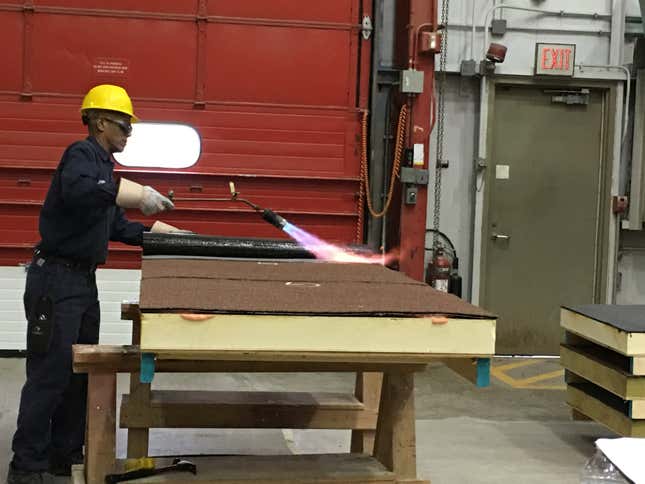
UL’s first standard, for tin-clad fire doors, was introduced in 1903, and it pretty much epitomizes what the company does. “Maybe the tests have been tweaked a little bit, but the concept is still to put the door in a furnace, and after an hour or so, we’ll see if it can withstand all that fire,” Drengenberg said.
Like Bell Labs, but for setting things on fire
UL employees over 12,000 people, tests roughly 20,000 products at offices in 46 countries worldwide each year, and pushes everything to the extreme. Drengenberg told me that every fridge the company tests has its door opened and closed by an automated machine 300,000 times. It takes days to complete, but it simulates years of regular use—the underlying idea being that if a child got trapped inside an old fridge, perhaps one that wasn’t properly disposed of, she’d still be able to kick her way out. It’s a weird foresight that can really only be amassed after decades testing the same products.
“We have to understand what humans do,” he added. “And everything your mother told you not to do as a child, that’s what we do here.”
The level of detail UL testers require can seem whimsical at times. They use a certain thickness of cheesecloths to simulate drapes that might come into contact with something electric and set a house on fire, and a certain shade of black paint to test appliances against. (Drengenberg tells me that’s because every person’s house will be decorated differently, so they wanted to standardize how products are tested against walls in case they catch fire.)
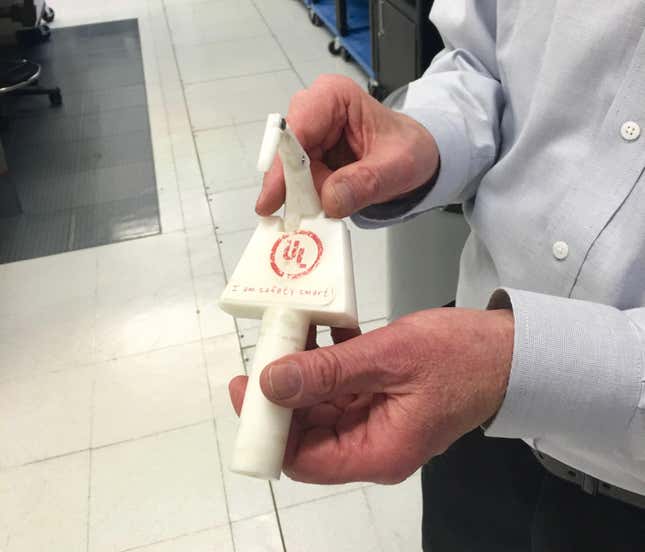
There’s even a specially designed articulated piece of plastic that employees call the “UL finger,” which can bend pretty much like a real finger can. Testers literally bash appliances with a dense metal ball suspended from the ceiling of one lab, and swing the ball at their target, trying to dent the products. After a good beating, they try to stick the UL finger into any openings that appear to see if curious digits could slip in and touch live parts of a damaged, but still operational unit. Manufacturers find this type of one-size standard for testing all products agreeable. “This is the finger: It’s not his finger, my finger, or yours,” Drengenberg said. “And you’ve not heard recently of many little kids, or adults, reaching in an opening and touching a live part. It doesn’t happen, because of the UL standard.”
“Even the clothing we put in the washing machine, it’s not the technician’s socks,” Drengenberg said. “We specify the size of each piece of fabric, the hemming on the fabric—even the weave of the cloth is specified by the standard. The standard is the king.”
Drengenberg showed me an industrial-grade pizza oven and said that even the pizza—pepperoni—that the UL testers put inside has to be uniform. “Pepperoni has a certain amount of grease in it, it takes a certain amount of time to cook,” Drengenberg said. “[The testers] had to specify a pizza, simply because we want this manufacturer’s test to be done the same as his competitor’s—it’s for the repeatability.”
Drengenberg showed me a massive room, probably bigger than the size of a football field, that UL engineers use to build fake rooms and houses. And like pretty much everything else at UL, they set them on fire. There were stacks of ratty couches, old lamps, shoddy coffee tables that they will put into their constructions to set on fire. We walked through one bungalow that was being built for the Department of Homeland Security, and was fitted with sensors to test how quickly air moves through a building when it’s on fire.

There were other buildings that had furnaces the size of two-story houses where engineers built entire walls and floors just to blast them with fire for hours, to see whether they would keep people safe in the event of a massive inferno. There were other furnaces that they put safes stuffed with newspaper in, and burned them for hours—the safe passed if you could read the news after the test. There were random parts of gurneys, tornado sirens, and spiralizers—the spinning attachments used to turn vegetables into strips—laying about, waiting to be tested. There were other buildings with ballistics ranges where automated guns tested bulletproof vests and windows. Anything that can potentially hurt you, large or small, will probably be tested in some capacity at UL.
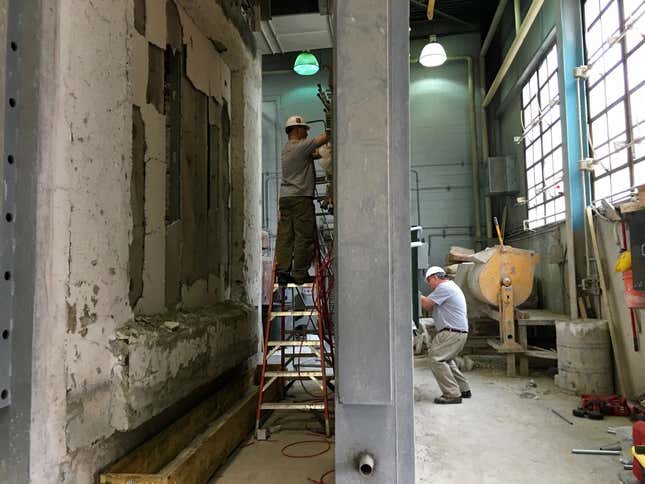
America is getting older, and because of debts, loans, lack of pensions and myriad other reasons, Americans are having to work for longer than previous generations had to. At the same time, most consumer electronics are produced outside of the US these days, so what keeps the 72-year-old coming back to work, long after the average retirement age, as he passes his 50 anniversary at UL? “I don’t know—momentum, maybe—I get up in the morning and what do I do? I get ready and I go to work,” Drengenberg said. He’s been an engineer, a manager, and an executive in his time at UL, and now spends his time talking to people like me and giving safety tips to whoever will listen. “I tested products galore as part of my career, but now I’ve got the chance to really talk to people,” he said. “And I really believe some of the things we say might catch in people’s minds, and we might’ve saved somebody just doing a simple interview.”
There’s little fanfare in the work they do in their beige block buildings in a nondescript suburb in the middle of the country. The work isn’t thankless—everyone’s getting paid to be there—but there’s not much recognition of what UL’s staff does to keep us safe, and Drengenberg and everyone else isn’t clamoring for it. They’re just working to ensure when the next hoverboard—the next viral fad—comes around they’ll be ready to test it.
But don’t expect to notice anything different. If you do, UL hasn’t done its job.
